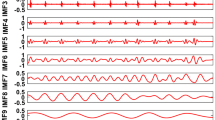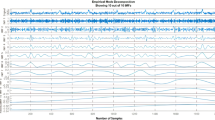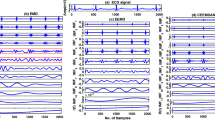Abstract
The diagnostic study of electrocardiography (ECG) signals plays a vital role in the diagnosis of cardiac problems. But the powerline interference in ECG causes an artifact in the interpretation of the original signal. In this paper, a new method for the removal of such noise/artifact from the ECG signal by combining stationary wavelet transform with empirical mode decomposition (EMD-SWT) and ensemble empirical mode decomposition (EEMD-SWT) is proposed. SWT is applied after the decomposition of ECG signals into various intrinsic mode functions (IMFs) for further removal of noise. The proposed methods are tested for various datasets available in MIT-BIH Arrhythmia database, and the performance has been validated with existing methods. From the simulated results, it is found that combining SWT with EMD and EEMD yields better SNR enhancement when compared to the traditional methods.











Similar content being viewed by others
References
S. Agrawal, A. Gupta, Fractal and EMD based removal of baseline wander and powerline interference from ECG signals. Comput. Biol. Med. 43, 1889–1899 (2013)
A.R. Al-Qawasmi, K. Daqrouq, ECG signal enhancement using wavelet transform. WSEAS Trans. Biol. Biomed. 2(7), 62–71 (2010)
K. Antczak Deep recurrent neural networks for ECG signal denoising. (2018) http://arxiv.org/abs/1807.11551.
C. T. C. Arsene, R. Hankins, H. Yin Deep learning models for denoising ECG signals. in Proceedings of the 27th European Signal Processing Conference. (2019) https://doi.org/10.23919/eusipco.2019.8902833.
K.M. Chang, Arrhythmia ECG noise reduction by ensemble empirical mode decomposition. Sensors. 10, 6063–6080 (2010)
H. Chiang, Y. Hsieh, S. Fu, K. Hung, Y. Tsao, S. Chien, Noise reduction in ECG signals using fully convolutional denoising autoencoders. IEEE Access. 7, 60806–60813 (2019)
E. Everss-Villalba, F.M. Melgarejo-Meseguer, M. Blanco-Velasco, F.J. Gimeno-Blanes, S. Sala-Pla, J.L. Rojo-Álvarez, A. García-Alberola, Noise maps for quantitative and clinical severity towards long-term ECG monitoring. Sensors (Switzerland). 17(11), 2448 (2017). https://doi.org/10.3390/s17112448
A.L. Goldberger et al., PhysioBank, PhysioToolkit, and PhysioNet: components of a new research resource for complex physiologic signals. Circulation 101(23), e215–e220 (2000)
J. Lee, D.D. McManus, S. Merchant, K.H. Chon, Automatic motion and noise artifact detection in holter ECG data using empirical mode decomposition and statistical approaches. IEEE Trans. Biomed. Eng. 59(6), 1499–1506 (2012)
A. Karagiannis, P. Constantinou, Noise-assisted data processing with empirical mode decomposition in biomedical signals. IEEE Trans. Inf Technol. Biomed. 15(1), 11–18 (2011)
S. Kuanar, V. Athitsos, N. Pradhan, A. Mishra, K. R. Rao Cognitive analysis of working memory load from EEG by a deep recurrent neural network. in Proceedings of the IEEE International Conference on Acoustics, Speech and Signal Processing.(2018), pp. 2576–2580
N. Kumaravel, N. Nithiyanandam, Genetic-algorithm cancellation of sinusoidal powerline interference in electrocardiograms. Med. Biol. Eng. Compu. 36, 191–196 (1998)
C. Lehmann, J. Reinstädtler, A. Khawaja, Detection of power-line interference in ECG signals using frequency-domain analysis. Comput. Cardiol. 38, 821–824 (2011)
Y.D. Lin, Y.H. Hu, Power-line interference detection and suppression in ECG signal processing. IEEE Trans. Biomed. Eng. 55(1), 354–357 (2008)
M. Maniruzzaman, K. M. S Billah, U. Biswas Bain B.: least-mean-square algorithm based adaptive filters for removing powerline interference from ECG signal. in Proceedings of IEEE International Conference on Informatics, Electronics and Vision (2012), pp. 737–740
S.M.M. Martens, M. Mischi, S.G. Oei, J.W.M. Bergmans, An improved adaptive power line interference canceller for electrocardiography. IEEE Trans. Biomed. Eng. 53(11), 2220–2231 (2006)
J. Mateo, C. Sanchez, A. Torres, R. Cervigon, J.J. Rieta, Neural network based canceller for powerline interference in ECG signals. Comput. Cardiol. 35, 1073–1076 (2008)
G.B. Moody, R.G. Mark, The impact of the MIT-BIH arrhythmia database. IEEE Eng. Med. Biol. Mag. 20(3), 45–50 (2001)
A. J. Nimunkar, W. J. Tompkins EMD-based 60-Hz noise filtering of the ECG. in Proceedings of the 29thAnnual International Conference of the IEEE Engineering in Medicine and Biology.(2007), pp. 1904–1907
M.Z.U. Rahman, R.A. Shaik, D.V. Rama Koti Reddy, Efficient sign based normalized adaptive filtering techniques for cancelation of artifacts in ECG signals: application to wireless biotelemetry. Signal Process 91, 225–239 (2011)
I. Romero, D. Geng, T. Berset, Adaptive filtering in ECG denoising: a comparative study. Comput. Cardiol. 39, 45–48 (2012)
D. Safieddine et al., Removal of muscle artifact from EEG data: comparison between stochastic (ICA and CCA) and deterministic (EMD and wavelet-based) approaches. EURASIP J. Adv. Signal Process. (2012). https://doi.org/10.1186/1687-6180-2012-127
M. Suchetha, N. Kumaravel, Empirical mode decomposition-based subtraction techniques for 50 hz interference reduction from electrocardiogram. IETE J. Res. 59(1), 55–62 (2013)
G. Wang, L. Yang, M. Liu, X. Yuan, P. Xiong, F. Lin, X. Liu, ECG signal denoising based on deep factor analysis. Biomed. Signal Process. Control (2020). https://doi.org/10.1016/j.bspc.2019.101824
Z. Wu, N.E. Huang, Ensemble empirical mode decomposition: a noise-assisted data analysis method. Adv. Adaptive Data Anal. 1, 01–41 (2009)
Z. Zhidong, M. Chan A novel cancellation method of powerline interference in ECG signal based on EMD and adaptive filter. in Proceedings of the International Conference on Communication Technology (2008), pp. 517–520
X. Zhou, Y. Zhang, A hybrid approach to the simultaneous eliminating of power-line interference and associated ringing artifacts in electrocardiograms. BioMedical Eng. Online. 12, 42 (2013). https://doi.org/10.1186/1475-925X-12-42
Author information
Authors and Affiliations
Corresponding author
Ethics declarations
Conflict of interest
The authors declare that they have no conflict of interest in this paper.
Additional information
Publisher's Note
Springer Nature remains neutral with regard to jurisdictional claims in published maps and institutional affiliations.
Rights and permissions
About this article
Cite this article
Dwivedi, A.K., Ranjan, H., Menon, A. et al. Noise Reduction in ECG Signal Using Combined Ensemble Empirical Mode Decomposition Method with Stationary Wavelet Transform. Circuits Syst Signal Process 40, 827–844 (2021). https://doi.org/10.1007/s00034-020-01498-4
Received:
Revised:
Accepted:
Published:
Issue Date:
DOI: https://doi.org/10.1007/s00034-020-01498-4




